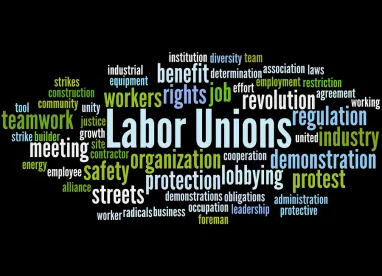Citing judicial criticism, as well as the original Supreme Court decisions on the issue, the NLRB swept away years of precedent permitting union representatives to access public areas of an employer’s premises.
In UPMC Presbyterian Shadyside, 368 NLRB No. 2 (June 14, 2019), the NLRB was confronted with the findings that an employer committed unfair labor practices when it ejected two union representatives from a cafeteria that was open to the public.
Common Occurrence – Presence of Union Representatives in Public Cafeteria
The case involved a fairly common occurrence. The employer, a hospital, had a cafeteria on the 11th floor of the building, which was open to the public.
Two non-employee union representatives visited the cafeteria where they sat with employees and discussed organizational campaign matters. Other employees stopped by to receive union literature and pins. A meeting was held by the union representatives which lasted for about an hour. An employee complained about the presence of the union representatives and a security officer was dispatched to the cafeteria. The security officer confronted the representatives and told them they had to leave because the cafeteria was only for patients, their families and visitors, and employees. During the encounter, the security officer asked for the identification of employees sitting at the table with the union representatives.
A union representative pointed out that a woman sitting in the cafeteria was a friend of an employee who was waiting to have lunch and asked if that person would have to leave as well. The security officer replied that the two union representatives would have to leave.
In the past, the employer had ejected two outside parties from soliciting in the cafeteria. There was no evidence that the employer knowingly allowed any other third party to solicit in its cafeteria.
The union filed charges which alleged that the employer’s actions in the cafeteria violated Section 8(a)(1) by (1) the ejection of the union representatives, (2) unlawful surveillance of employees and (3) by requiring employees to provide identification.
The Administrative Law Judge concluded that the employer committed an unfair labor practice as to all three of the allegations.
NLRB Majority Reviews Law and Concludes Employer Did Not Unlawfully Eject the Union Representatives or Unlawfully Surveil Employees
Three Board Members (Ring, Emanuel and Kaplan) reversed the ALJ as to the first two issues, concluding that the NLRB had departed from existing Supreme Court precedent in a manner that had been heavily criticized by circuit courts of appeal. The NLRB reviewed the Supreme Court’s decision in NLRB v. Babcock and Wilcox Co., 351 U.S. 105, 112 (1956) which set forth the standard for nonemployee access to an employer’s property. In that decision, the Supreme Court held:
It is our judgment . . .that an employer may validly post his property against nonemployee distribution of union literature if reasonable efforts by the union though other available channels of communication will enable it to reach the employees with its message and if the employer’s notice or order does not discriminate against the union by allowing other distribution.
The NLRB noted that the two exceptions to circumstances where an employer can bar nonemployee organizers from the premises, inaccessibility and discrimination, were intended to be narrowly construed given the importance of private property rights. The Board noted that over the years, despite applying the principles of Babcock and Wilcox, the Board “created an additional exception where nonemployee union organizers seek access to a portion of the employer’s property that is open to the public, such as a cafeteria or restaurant.” In this regard, the Board noted that it has “consistently found that employers violate Section 8(a)(1) of the Act when the restrict public-cafeteria access for nonemployee organizers who engage in solicitation and other promotional activities but are not ‘disruptive.'”
The Board majority noted that this approach had been “soundly rejected” by a number of federal circuit courts of appeal and seemed inconsistent with the original analysis provided by the Supreme Court. The Board then announced that it would reverse all cases supporting this third exception:
Therefore, to the extent that Board law created a “public space” exception that requires employers to permit nonemployees to engage in promotional or organizational activity in public cafeterias or restaurants absent evidence of inaccessibility or activity-based discrimination, we overrule those decisions.
The Board then announced the new rule for addressing nonemployees access to an employer’s area that is open to the public:
Accordingly, we find that an employer does not have a duty to allow the use of its facility by nonemployees for promotional or organization activity. The fact that a cafeteria located on the employer’s private property is open to the public does not mean that an employee must allow any nonemployee access for any purpose. Absent discrimination between nonemployee union representatives and other nonemployees –i.e., ‘disparate treatment where by rule or practice a property owner’ bars access by nonemployee union representatives seeing to engage in certain activity ‘while permit[ting] similar activity in similar relevant circumstances’ by other nonemployees–the employer may decide what types of activities, if any, it will allow by nonemployees on its property.
The Board then applied this new rule retroactively to all cases.
The Board’s application of the new rule to the case resulted in no violation of the law as to the ejection of the union organizers. The Board first noted that the issue was not inaccessibility. So, the issue was whether the employer acted discriminatorily by ejecting the union representatives. Here, the employer demonstrated that it had taken action in the past to prohibit solicitation by outside parties. The Board did not see an inconsistency between the fact that there was a nonemployee friend waiting in the cafeteria because that person was not soliciting others. The employer acted consistently with how it had treated outsiders engaged in solicitation and that was all that mattered.
The Board went out of its way to make clear that it was reversing any “precedent holding discrimination can be established merely by showing that the nonemployee union representatives were denied access to a public area within private property, without the Board considering the kind of ‘nondisruptive’ activity they were engaged in and whether the employer had permitted similar activity by other nonemployees.”
As to the second issue, whether the security guard engaged in unlawful surveillance, the Board concluded that the employer did not engage in surveillance because of longstanding precedent that recognizes that “management officials may observe public union activity, particularly where such activity occurs on company premises, without violating Section 8(a)(1) of the Act, unless such officials do something out of the ordinary.”
The Board did find a violation of the law for the security guard requesting identification from the employees present at the impromptu union meeting. The Board held this action was chilling of protective rights.
Dissent Decries Overruling Precedent
Member McFerran dissented alleging, among other things, that the majority had misread the law. The dissent’s opinion, weighing in at 10 pages, decried the overruling of precedent without proper notice, which has been a rallying cry of McFerran’s:
Today’s decision continues an unfortunate trend the Board. Again, the majority mistakenly reverses precedent–narrowly statutory protections for employees and unions–without first providing notice to the public and inviting briefs, in a case that does not present a proper occasion for reconsidering the law.
Takeaways
Employers with cafeterias open to the public now have a bright line rule. The employer now can bar any nonemployee from soliciting, including union organizers, so long as they bar all other nonemployees from similar activities. A violation can no longer be established merely by the fact the employer barred a union representative from a public area. The General Counsel must prove that the employer allowed similar conduct by other third parties before an allegation of disparate treatment can be established.
It is critical that the employer have a lawful non-distribution/non-solicitation policy in writing. The employer must also, of course, uniformly enforce the policy across all third parties in order for this new case law to apply.
The true impact of this decision has yet to be seen as it is possible the new rule will just shift the focus of litigation to allegations of disparate treatment which can be hard to defend. It is very important for employers to keep a written record of the instances in which they have enforced a valid non-solicitation/non-distribution so that they have evidence to defend claims of disparate treatment.
As to the notion that the Board is departing from some policy, written or otherwise, by not inviting briefs from the public, this criticism is hard to square with the practice of the agency in the last several years, if not decades. While it may be ideal for the public to weigh in on significant changes to the law, the fact is the Board is not obligated to reach out to the public on every precedent change; certainly this has not been the agency’s practice. In the last 10 years, prior Boards often overturned significant precedent with no notice to the public. For sure, the prior Boards invited briefs on substantial issues, such as the joint employer standard, but there were many precedent changes the Board characterized as “significant” that were just announced without any prior notice and often without a quorum



 />i
/>i

